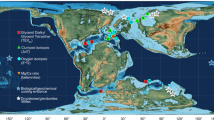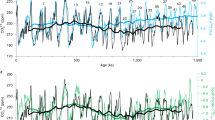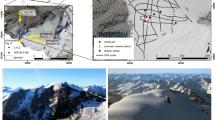Abstract
A massive CO2 ice deposit overlies1 part of Mars’s primarily H2O ice2,3,4 south polar cap5. This deposit rivals the mass of Mars’s current, 96% CO2, atmosphere6. Its release could substantially alter Mars’s pressure and climate1. The deposit consists of alternating CO2 and H2O ice layers to a depth of up to approximately 1 km (refs. 1,7,8). The top layer is an enigmatic9,10,11 1–10 m covering of perennial surface CO2 ice12 called the residual south polar cap. Typical explanations of the layering invoke orbital cycles1,7. Up to now, models assumed that the H2O ice layers insulate and seal in the CO2, allowing it to survive high-obliquity periods7,13. However, these models do not quantitatively predict the deposit’s stratigraphy or explain the residual south polar cap’s existence. Here we present a model in which the deposit’s near-surface CO2 can instead exchange with the atmosphere through permeable H2O ice layers. Using currently observed albedo14,15 and emissivity16 properties of the Martian polar CO2 ice deposits, our model predicts that the present massive CO2 ice deposit is a remnant of larger CO2 ice deposits laid down during periods of decreasing obliquity that are ablated, liberating a residual lag layer of H2O ice, when obliquity increases. Fractions of previous CO2 deposits remain as layers because the amplitudes of the obliquity maxima have been mostly decreasing during the past ~510 kyr (ref. 17). Our model simultaneously explains the observed massive CO2 ice deposit stratigraphy, the residual south polar cap’s existence and the presence of a massive CO2 ice deposit only in the south. We use our model to calculate Mars’s pressure history and determine that the massive CO2 ice deposit is 510 kyr old.
This is a preview of subscription content, access via your institution
Access options
Access Nature and 54 other Nature Portfolio journals
Get Nature+, our best-value online-access subscription
$29.99 / 30 days
cancel any time
Subscribe to this journal
Receive 12 digital issues and online access to articles
$119.00 per year
only $9.92 per issue
Buy this article
- Purchase on Springer Link
- Instant access to full article PDF
Prices may be subject to local taxes which are calculated during checkout




Similar content being viewed by others
Data availability
The radar and image datasets that support the findings of this study are publicly available from the NASA Planetary Data System (https://pds.nasa.gov). Source data for Fig. 3 are provided with the paper.
Code availability
The code that produces the figures and numerical results stated in the text is available from the corresponding author on reasonable request.
References
Phillips, R. J. et al. Massive CO2 ice deposits sequestered in the south polar layered deposits of Mars. Science 332, 838–841 (2011).
Ingersoll, A. P. Mars—the case against permanent CO2 frost caps. J. Geophys. Res. 79, 3403–3410 (1974).
Nye, J., Durham, W. B., Schenk, P. M. & Moore, J. M. The instability of a south polar cap on Mars composed of carbon dioxide. Icarus 144, 449–455 (2000).
Titus, T. N., Kieffer, H. H. & Christensen, P. R. Exposed water ice discovered near the south pole of Mars. Science 299, 1048–1051 (2003).
Byrne, S. The polar deposits of Mars. Annu. Rev. Earth Planet. Sci. 37, 535–560 (2009).
Hess, S. L., Ryan, J. A., Tillman, J. E., Henry, R. M. & Leovy, C. B. The annual cycle of pressure on Mars measured by Viking Landers 1 and 2. Geophys. Res. Lett. 7, 197–200 (1980).
Bierson, C. J. et al. Stratigraphy and evolution of the buried CO2 deposit in the Martian south polar cap. Geophys. Res. Lett. 43, 4172–4179 (2016).
Putzig, N. E. et al. Three-dimensional radar imaging of structures and craters in the Martian polar caps. Icarus 308, 138–147 (2018).
Byrne, S. & Ingersoll, A. P. A sublimation model for martian south polar ice features. Science 299, 1051–1053 (2003).
Thomas, P. C. et al. Mass balance of Mars’ residual south polar cap from CTX images and other data. Icarus 268, 118–130 (2016).
Malin, M. C., Caplinger, M. A. & Davis, S. D. Observational evidence for an active surface reservoir of solid carbon dioxide on Mars. Science 294, 2146–2148 (2001).
Kieffer, H. H. Mars south polar spring and summer temperatures: a residual CO2 frost. J. Geophys. Res. 84, 8263–8288 (1979).
Manning, C. V., Bierson, C., Putzig, N. E. & McKay, C. P. The formation and stability of buried polar CO2 deposits on Mars. Icarus 317, 509–517 (2019).
Paige, D. A. & Ingersoll, A. P. Annual heat balance of martian polar caps: Viking observations. Science 228, 1160–1168 (1985).
James, P. B., Kieffer, H. H., and Paige, D. A. in Mars (eds Kieffer, H. H., Jakosky, B. M., Snyder, C. W. & Matthews, M. S.) pp. 934–968 (Univ. Arizona Press, 1992).
Hayne, P. O. et al. Carbon dioxide snow clouds on Mars: south polar winter observations by the Mars Climate Sounder. J. Geophys. Res. 117, E08014 (2011).
Laskar, J. et al. Long term evolution and chaotic diffusion of the insolation quantities of Mars. Icarus 170, 343–364 (2004).
Guo, X., Richardson, M. I., Soto, A. & Toigo, A. On the mystery of the perennial carbon dioxide cap at the south pole of Mars. J. Geophys. Res. Planets 115, 1–13 (2010).
Haberle, R. M. et al. The effect of ground ice on the Martian seasonal CO2 cycle. Planet. Space Sci. 56, 251–255 (2008).
Fanale, F. P., Salvail, J. R., Banerdt, W. B. & Saunders, R. S. Mars: the regolith-atmosphere-cap system and climate change. Icarus 50, 381–407 (1982).
Jakosky, B. M. & Haberle, R. M. Year-to-year instability of the Mars south polar cap. J. Geophys. Res. Solid Earth 95, 1359–1365 (1990).
Brown, A. J., Piqueux, S. & Titus, T. N. Interannual observations and quantification of summertime H2O ice deposition on the Martian CO2 ice south polar cap. Earth Planet. Sci. Lett. 406, 102–109 (2014).
Byrne, S., Zuber, M. T. & Neumann, G. A. Interannual and seasonal behavior of Martian residual ice-cap albedo. Planet. Space Sci. 56, 194–211 (2008).
Haberle, R. M. et al. Preliminary interpretation of the REMS pressure data from the first 100 sols of the MSL mission. J. Geophys. Res. Planets 19, 440–453 (2014).
Hu, R., Kass, D. M., Ehlmann, B. L. & Yung, Y. L. Tracing the fate of carbon and the atmospheric evolution of Mars. Nat. Commun. 6, 10003 (2015).
Jakosky, B., Henderson, B. & Mellon, M. Chaotic obliquity and the nature of the Martian climate. J. Geophys. Res. 100, 1579–1584 (1995).
Leighton, R. B. & Murray, B. C. Behavior of carbon dioxide and other volatiles on Mars. Science 153, 136–144 (1966).
Murray, B. C. & Malin, M. C. Polar volatiles on Mars—theory versus observation. Science 182, 437–443 (1973).
Byrne, S. & Ingersoll, A. P. Martian climatic events on timescales of centuries: evidence from feature morphology in the residual south polar ice cap. Geophys. Res. Lett. 30, 2–5 (2003).
Giauque, W. F. & Stout, J. W. The entropy of water and the third law of thermodynamics. The heat capacity of ice from 15 to 273°K. J. Am. Chem. Soc. 58.7, 1144–1150 (1936).
Slack, G. A. Thermal conductivity of ice. Phys. Rev. B 22, 3065–3071 (1980).
Phillips, R. J. et al. Mars north polar deposits: stratigraphy, age, and geodynamical response. Science 320, 1182–1185 (2008).
Ruiz, J., López, V. & Dohm, J. M. The present-day thermal state of Mars. Icarus 207, 631–637 (2010).
Schubert, G., Solomon, S. C., Turcotte, D. L., Drake, M. J. & Sleep, N. H. in Mars (eds Kieffer, H. H., Jakosky, B. M., Snyder, C. W. & Matthews, M. S.) pp. 147–183 (Univ. Arizona Press, 1992).
Zuber, M. T. et al. Internal structure and early thermal evolution of Mars from Mars Global Surveyor topography and gravity. Science 287, 1788–1793 (2000).
Dehant, V. et al. Future Mars geophysical observatories for understanding its internal structure, rotation, and evolution. Planet. Space Sci. 68, 123–145 (2012).
Montabone, F. et al. Eight-year climatology of dust optical depth on Mars. Icarus 251, 65–95 (2015).
Hourdin, F., Le Van, P., Forget, F. & Talagrand, O. Meteorological variability and the annual surface pressure cycle on Mars. J. Atmos. Sci. 50, 3625–3640 (1993).
Houben, H., Haberle, R. M., Young, R. E. & Zent, A. P. Modeling the Martian seasonal water cycle. J. Geophys. Res. Planets 102, E4 (1997).
Richardson, M. I. & Wilson, R. J. Investigation of the nature and stability of the Martian seasonal water cycle with a general circulation model. J. Geophys. Res. Planets 107, 5031 (2002).
Montmessin, F. et al. On the origin of perennial water ice at the south pole of Mars: a precession-controlled mechanism? J. Geophys. Res. 112, E08S17 (2007).
Clancy, R. T. et al. Water vapor saturation at low altitudes around Mars aphelion: a key to Mars climate? Icarus 122, 36–62 (1996).
Kelly, N. J. et al. Seasonal polar carbon dioxide frost on Mars: CO2 mass and columnar thickness distribution. J. Geophys. Res. Planets 112, 1–12 (2007).
Paige, D. A. The Annual Heat Balance of the Martian Polar Caps from Viking Observations. PhD thesis, California Institute of Technology (1985).
Hapke, B. Combined Theory of Reflectance and Emittance Spectroscopy 2nd edn (Cambridge Univ. Press, 2012).
Alwarda, R. and Smith, I. B. Mapping and characterization of the bounding layers of the CO2 deposit in Planum Australe, Mars. In 50th Lunar and Planetary Science Conference 2132 (2019).
Piqueux, S. & Christensen, P. R. A model of thermal conductivity for planetary soils: 2. Theory for cemented soils. J. Geophys. Res. 114, E09006 (2009).
Acknowledgements
P.B.B. was supported by NASA Earth and Space Sciences Fellowship NNX16AP38H and the NASA Postdoctoral Program. Early work by B.L.E., P.B.B. and A.P.I. was partially supported by the NASA Mars Fundamental Research grant NNX14AG54G to B.L.E. and C. Pilorget. Part of this work was performed at the Jet Propulsion Laboratory, California Institute of Technology, under a contract with NASA. Government support acknowledged.
Author information
Authors and Affiliations
Contributions
P.B.B. conceived of the study, performed the numerical modelling and data analysis, and wrote the paper. Substantial discussions with A.P.I., S.P., B.L.E. and P.O.H. refined the results of the study and the manuscript presentation.
Corresponding author
Ethics declarations
Competing interests
The authors declare no competing interests.
Additional information
Peer review information Nature Astronomy thanks Isaac Smith and the other, anonymous, reviewer(s) for their contribution to the peer review of this work.
Publisher’s note Springer Nature remains neutral with regard to jurisdictional claims in published maps and institutional affiliations.
Extended data
Extended Data Fig. 1 Energy balance model schematic and model output comparison to data.
Left. Schematic of the energy balance model (Equation 1). Right. One-year model outputs with incoming flux (orange), outgoing flux (red dashed), and modelled accumulated CO2 (purple line), compared to observed accumulated CO2 (purple points; Kelly et al. (2006)43). LS is solar longitude. Apparent line-width of incoming flux is due to daily insolation oscillations, which are not resolved at plot resolution. The small fluctuations in the incoming flux curve are due to seasonal variations in the atmospheric opacity (Extended Data Fig. 3). Model runs for current orbit (obliquity = 25.19°, eccentricity = 0. 0934, longitude of perihelion = 251°). H2O layer thickness = 15 m. A. Latitude = 89.5°S, pressure = 1.0 × Peq,0, elevation = 4750 m, \({\it{\epsilon }}_{CO_2}\)= 0.8. B. Same, but with pressure = 0.95 × Peq,0, \({\it{\epsilon }}_{H_2O}\) = 1.0, \(A_{H_2O}\) = 0.4. C. Latitude = 89.5° N, pressure = 1.00 × Peq,0, elevation = −2000 m, \({\it{\epsilon }}_{CO_2}\)= 0.485, \({\it{\epsilon }}_{H_2O}\) = 0.55, \(A_{H_2O}\) = 0.4.
Extended Data Fig. 2 Examples of metre- to 10-metre-scale polygonal patterning (white arrows) on the H2O ice layer overlying the MCID, adjacent to and beneath mesas of RSPC CO2 (black arrows).
Locations of panels are indicated in Extended Data Fig. 5A. HiRISE images A. ESP_014179_0930 B. ESP_058543_0930 C. PSP_003716_0930 D. ESP_058527_0940 E. ESP_058896_0910 F. ESP_058119_0940 G. ESP_041120_0920 H. ESP_014182_0960.
Extended Data Fig. 3
Opacity data from Montabone et al. (2015) from 87–90° S, -90-0° E from Mars Years 27–33, with mean (black) and median (grey) values.
Extended Data Fig. 4 Effect of varying obliquity on absorbed insolation due to albedo dependence on insolation.
(Blue) Total annual incident insolation at 89.5°S normalized to maximum annual incident insolation (at 90° obliquity); (Orange) total absorbed insolation, normalized to maximum annual absorbed insolation (at 36° obliquity); (Green) equivalent mean annual albedo. The equivalent mean annual albedo is calculated from one minus the ratio of the sum of the absorbed insolation at each 30-minute time step throughout one Mars year divided by the sum of the incident insolation at each 30-minute time step throughout one Mars year. At each time step the albedo is calculated from Equation 4 at 89.5° S and zero eccentricity. Nonzero eccentricities slightly modify the obliquity at which peak annual absorbed insolation occurs and are taken into account when we calculate the instantaneous albedo at each time step in our model.
Extended Data Fig. 5 Regional context of textures in topmost H2O ice layer, timing of seasonal exposure of topmost H2O ice layer, and topmost H2O ice layer seasonal thermal profile.
Top Left. CTX mosaic context for top right panel (black rectangle) and panels in Extended Data Fig. 2 (blue dots labelled A–H). Top Right. Regions of dark H2O layer are exposed by LS 297 (HiRISE image ESP_013775_0931). The regions correspond to kilometre-scale depressions in the H2O layer1. Bottom panels show time progression of modelled thermal profile for a 20 m thick H2O layer overlying a semi-infinite CO2 layer that becomes exposed at LS 301. The basal temperature of the H2O reaches the CO2 sublimation temperature between LS 335 and LS 183 the following year. LS 300: last day of seasonal CO2 coverage. LS 301: first LS bare H2O is exposed. LS 316: maximum surface temperature reached. LS 335: basal temperature of H2O layer reaches CO2 sublimation temperature. LS 355: surface CO2 condenses. LS 90: winter solstice; thermal wave decaying. LS 183: last LS basal temperature of H2O layer is at CO2 sublimation temperature. LS 270: summer solstice; basal temperature of H2O layer ~1 K below CO2 sublimation temperature.
Source data
Source Data Fig. 3
Model pressure history for Fig. 3b.
Rights and permissions
About this article
Cite this article
Buhler, P.B., Ingersoll, A.P., Piqueux, S. et al. Coevolution of Mars’s atmosphere and massive south polar CO2 ice deposit. Nat Astron 4, 364–371 (2020). https://doi.org/10.1038/s41550-019-0976-8
Received:
Accepted:
Published:
Issue Date:
DOI: https://doi.org/10.1038/s41550-019-0976-8
This article is cited by
-
Mars and the ESA Science Programme - the case for Mars polar science
Experimental Astronomy (2022)



